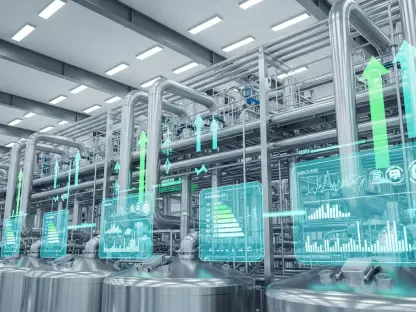In an era where technological advancement is reshaping the fabric of global economies, artificial intelligence (AI) stands out as a transformative force that is accelerating at a pace far beyond traditional benchmarks, challenging the very principles that have long guided tech progress. Historically, Moore’s Law, which posits that computing power doubles roughly every two years, has been a guiding principle for tech progress. However, recent analyses reveal that AI compute demand is growing at over twice that rate, creating an unprecedented challenge for infrastructure and resources. This staggering surge is not just a statistic but a signal of a paradigm shift, where data centers are becoming as critical as oil once was to industrial economies. With annual investments of $500 billion needed to keep up with this demand, the implications stretch across industries, energy systems, and financial markets, raising questions about sustainability and opportunity in equal measure. This rapid evolution demands attention, as it redefines how technology integrates into daily life and global commerce.
Unprecedented Compute Demand Redefines Tech Horizons
The scale of AI’s growth is nothing short of revolutionary, outstripping even the most ambitious historical trends in computing power. Unlike the predictable doubling of capabilities under Moore’s Law, AI’s compute needs are expanding at an exponential rate, driven by increasingly complex algorithms and vast data sets that power everything from language models to autonomous systems. Market commentators have highlighted that this trajectory creates a critical shortage of processing capacity, pushing tech companies and governments to rethink infrastructure priorities. The urgency to scale up is evident as industries race to harness AI’s potential for innovation in sectors like healthcare, finance, and manufacturing. Yet, this rapid ascent also exposes vulnerabilities, as existing systems struggle to keep pace with the sheer volume of computational requirements. The gap between demand and supply is widening, signaling a turning point where adaptation becomes not just a choice but a necessity for staying competitive in a digitally driven world.
Beyond the raw numbers, the implications of this compute surge are reshaping economic landscapes in profound ways. To meet these needs, projections estimate that global spending on data centers must reach $900 billion by 2028, with a staggering $500 billion required each year through 2030. This financial commitment underscores the transformation of data centers into a cornerstone of modern economies, often likened to essential commodities of past industrial eras. In the United States alone, construction projects for data centers are valued at $40 billion, marking a dramatic shift in investment focus that is poised to eclipse traditional sectors like office building development. This pivot reflects a broader recognition that AI infrastructure is no longer a niche concern but a fundamental driver of technological and economic progress. However, the sheer magnitude of these investments also prompts scrutiny over whether such growth can be sustained without triggering unforeseen economic pressures or resource constraints.
Energy Challenges Loom Large Amid AI Expansion
As AI compute demand skyrockets, so too does the strain on global energy resources, presenting a formidable challenge to sustainability efforts. Data centers, the backbone of AI operations, are projected to consume a staggering 1,600 terawatt-hours of electricity by 2035, representing approximately 4.4% of the world’s total supply. This quadrupling of energy use over the next decade raises critical questions about the capacity of current power grids to support such an escalation. Environmental concerns are mounting, as the carbon footprint of these facilities could undermine global efforts to combat climate change if not addressed with innovative solutions. Tech giants and policymakers are thus under pressure to explore renewable energy sources and energy-efficient designs to mitigate the impact. The intersection of technological advancement and ecological responsibility has never been more pronounced, highlighting the need for a balanced approach to growth that doesn’t sacrifice long-term planetary health for short-term gains.
The energy dilemma extends beyond environmental impact to influence economic and operational strategies across industries. With AI-related projects accounting for nearly 40% of capital expenditures among major corporations in the S&P 500, the financial burden of powering this revolution is becoming a central concern. Companies are compelled to invest not only in infrastructure but also in technologies that optimize energy consumption, such as advanced cooling systems and AI-driven power management tools. Meanwhile, the risk of energy shortages could disrupt the rollout of critical AI applications, potentially stalling progress in fields reliant on real-time data processing. This dynamic creates a complex puzzle, where the drive for innovation must be matched by equally robust solutions to resource challenges. As the industry grapples with these issues, collaboration between tech leaders, energy providers, and regulators will be essential to ensure that the AI boom does not come at an unsustainable cost to global systems or economic stability.
Market Dynamics and the Risk of Overvaluation
The financial fervor surrounding AI has sparked a modern gold rush, with early adopters viewing it as a generational opportunity to redefine industries and markets. Corporate investment in AI technologies is surging, with significant portions of budgets allocated to research, development, and infrastructure to capitalize on this transformative wave. Analysts have noted that the tangible growth in AI adoption—evidenced by widespread integration into business operations—sets this cycle apart from speculative tech booms of the past. Yet, beneath the optimism lies a cautious undercurrent, as the scale of investment raises questions about whether the market can absorb such rapid expansion without correction. The stakes are high, as businesses and investors navigate a landscape where the promise of innovation must be balanced against the practicalities of implementation and return on investment, shaping a narrative of both potential and prudence.
Contrasting perspectives among industry leaders further complicate the outlook for AI’s financial trajectory. While some prominent figures express concern over possible market overheating—drawing parallels to the dot-com bubble of the early 2000s—others argue that the current boom is grounded in real-world applications and measurable outcomes. Financial institutions have weighed in, suggesting that the depth of corporate commitment and consumer adoption provides a stronger foundation than past speculative frenzies. This debate underscores a critical uncertainty: whether the pace of investment in AI will lead to sustainable growth or precipitate a sharp downturn if expectations outstrip reality. The diversity of opinions reflects the complexity of predicting long-term trends in a field evolving at breakneck speed. As stakeholders assess risks and rewards, the AI market remains a dynamic arena where confidence and caution coexist, shaping strategic decisions that will influence technological and economic futures for years to come.
Reflecting on a Transformative Era
Looking back, the meteoric rise of AI marked a defining chapter in technological history, where compute demand outpaced even the boldest predictions and reshaped global priorities. The immense $500 billion annual investments in data centers became a testament to the urgency of supporting this growth, while the quadrupling of energy consumption by 2035 revealed the hidden costs of progress. Debates over market stability echoed through boardrooms and financial analyses, balancing the thrill of innovation against the specter of overvaluation. Yet, what stood out was the sheer scale of adaptation required to sustain this trajectory. Moving forward, the focus shifted to forging partnerships across sectors to address energy challenges and ensure infrastructure kept pace with ambition. Strategic planning for renewable integration and efficient systems emerged as actionable steps, while continuous dialogue among industry leaders offered a path to navigate uncertainties. This era underscored that harnessing AI’s potential demanded not just investment, but a commitment to sustainable and balanced growth.









